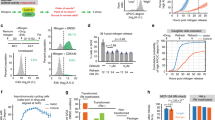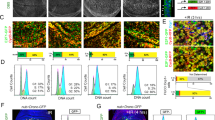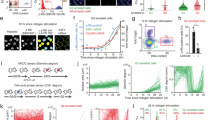Abstract
Depsipeptide, FR901228, a novel cyclic peptide inhibitor of histone deacetylase with a unique cytotoxicity profile is currently in phase I clinical trials. Here we demonstrate that, in addition to G2/M arrest, FR901228 causes G1 arrest with Rb hypophosphorylation. In vitro kinase assays demonstrated no direct inhibition of CDK activity, however, an inhibition was observed in CDKs extracted from cells exposed to FR901228. Cyclin D1 protein disappeared between 6 and 12 hours after treatment with FR901228, whereas cyclin E was upregulated. While it did not induce wt p53, FR901228 did induce p21WAF1/CIP1in a p53-independent manner. Cell clones lacking p21 were not arrested in G1 phase, but continued DNA synthesis and were arrested in G2/M phase following FR901228 treatment. Finally, FR901228 blunted ERK-2/MAPK activation by EGF whereas early signal transduction events remained intact since overall cellular tyrosine phosphorylation after EGF stimulation was unaffected. Thus, FR901228, while not directly inhibiting kinase activity, causes cyclin D1 downregulation and a p53-independent p21 induction, leading to inhibition of CDK and dephosphorylation of Rb resulting in growth arrest in the early G1 phase. In contrast to the G1 arrest, the G2/M arrest is p21-independent, but is associated with significant cytotoxicity. © 2000 Cancer Research Campaign
Similar content being viewed by others
Article PDF
Change history
16 November 2011
This paper was modified 12 months after initial publication to switch to Creative Commons licence terms, as noted at publication
References
Aktas H, Cai H and Cooper GM (1997) Ras links growth factor signaling to the cell cycle machinery via regulation of cyclin D1 and the Cdk inhibitor p27KIP1. Mol Cell Biol 17: 3850–3857
Archer SY, Meng S, Shei A and Hodin RA (1998) p21WAF1 is required for butyrate-mediated growth inhibition of human colon cancer cells. Proc Natl Acad Sci USA 95: 6791–6796
Blagosklonny MV (1999) A node between proliferation, apoptosis, and growth arrest. BioEssays 21: 704–709
Blagosklonny MV, Somasundaram K, Wu GS and El-Deiry WS (1997) Wild-type p53 is not sufficient for serum starvation-induced apoptosis in cancer cells but accelerates apoptosis in sensitive cells. Int J Oncol 11: 1165–1170
Botz J, Zerfass-Thome K, Spitkovsky D, Delius H, Vogt B, Eilers M, Hatzigeorgiou A and Jansen-Durr P (1996) Cell cycle regulation of the murine cyclin E gene depends on an E2F binding site in the promoter. Mol Cell Biol 16: 3401–3409
Brehm A, Miska EA, McCance DJ, Reid JL, Bannister AJ and Kouzarides T (1998) Retinoblastoma protein recruits histone deacetylase to repress transcription. Nature 391: 597–601
Bunz F, Dutriaux A, Lengauer C, Waldman T, Zhou S, Brown JP, Sedivy JM, Kinzler KW and Vogelstein B (1998) Requirement for p53 and p21 to sustain G2 arrest after DNA damage. Science 282: 1497–1501
Campisi J, Medrano EE, Morreo G and Pardee A (1982) Restriction point control of cell growth by a labile protein: evidence for increased stability in transformed cells. Proc Natl Acad Sci USA 79: 436–440
Candido EPM, Reeves R and Davie JR (1978) Sodium butyrate inhibits histone deacetylation in cultured cells. Cell 14: 105–113
Chen X, Bargonetti J and Prives C (1995) P53, through p21 (WAF1/CIP1), induces cyclin D1 synthesis. Cancer Res 55: 4257–4263
DeGregori J, Leone G, Ohtani K, Miron A and Nevins J (1995) E2F-1 accumulation bypasses a G1 arrest resulting from the inhibition of G1 cyclin-dependent kinase activity. Genes Dev 9: 2873–2887
El-Deiry WS, Tokino T, Veculescu VE, Levy DB, Parsons R, Trent JM, Lin D, Mercer WE, Kinzler KW and Vogelstein B (1993) WAF1, a potential mediator of p53 tumor suppression. Cell 75: 817–825
Gong JP, Traganos F and Darzynkiewicz Z (1994) Use of the cyclin E restriction point to map cell arrest in G(1)-induced by N-butyrate, cycloheximide, staurosporine, lovastatin, mimosine and quercetin. Int J Oncol 4: 803–808
Grignani F, De Matteis S, Nervi C, Tomassoni L, Gelmetti V, Cioce M, Fanelli M, Ruthardt M, Ferrara FF, Zamir I, Seiser C, Grignani F, Lazar MA, Minucci S and Pelicci PG (1998) Fusion proteins of the retinoic acid receptor-alpha recruit histone deacetylase in promyelocytic leukemia. Nature 391: 815–818
Hunter T (1997) Oncoprotein networks. Cell 88: 333–346
Johnson DG, Schwarz JK, Cress WD and Nevins JR (1993) Expression of transcription factor E2F1 induces quiescent cells to enter S-phase. Nature 365: 349–352
Juan G, Li X and Darzynkiewicz Z (1998) Phosphorylation of retinoblastoma protein assayed in individual HL-60 cells during their proliferation and differentiation. Exp Cell Res 244: 83–92
Kim YB, Lee KH, Sugita K, Yoshida M and Horinouchi S (1999) Oxamflatin is a novel antitumor compound that inhibits mammalian histone deacetylase. Oncogene 18: 2461–2470
Kosugi H, Towatari M, Hatano S, Kitamura K, Kiyoi H, Kinoshita T, Tanimoto M, Murate T, Kawashima K, Saito H and Naoe T (1999) Histone deacetylase inhibitors are the potent inducer/enhancer of differentiation in acute myeloid leukemia: a new approach to anti-leukemia therapy. Leukemia 13: 1316–1324
Lee JS, Paull K, Alvarez M, Hose C, Monks A, Grever M, Fojo AT and Bates SE (1994) Rhodamine efflux patterns predict P-glycoprotein substrates in the National Cancer Institute drug screen. Mol Pharmacol 46: 627–638
Lin RJ, Nagy L, Inoue S, Shao W, Miller WH and Evans RM (1998) Role of the histone deacetylase complex in acute promyelocytic leukemia. Nature 391: 811–814
Luo RX, Postigo AA and Dean DC (1998) Rb interacts with histone deacetylase to repress transcription. Cell 92: 463–473
Magnaghi-Jaulin L, Groisman R, Naguibneva I, Robin P, Lorain S, Le Villain JP, Troalen F, Trouche D and Harel-Bellan A (1998) Retinoblastoma protein repress transcription by recruiting a histone deacetylase. Nature 391: 601–605
Nakajima H, Kim YB, Terano H, Yoshida M and Horinouchi S (1998) FR901228, a potent antitumor antibiotic, is a novel histone deacetylase inhibitor. Exp Cell Res 241: 126–133
Nevins JR (1998) Toward an understanding of the functional complexity of the E2F and retinoblastoma families. Cell Growth Diff 9: 585–593
Oswald F, Lovec H, Moroy T and Lipp M (1994) E2F-dependent regulation of human MYC: trans-activation by cyclins D1 and A overrides tumour suppressor protein function. Oncogene 9: 2029–2036
Pardee AB (1974) A restriction point for control of normal animal cell proliferation. Proc Natl Acad Sci USA 71: 1286–1290
Polyak K, Waldman T, He T-C, Kinzler KW and Vogelstein B (1996) Genetic determinants of p53-induced apoptosis and growth arrest. Genes Dev 10: 1945–1952
Rajgolikar G, Chan KK and Wang HC (1998) Effects of a novel antitumor depsipeptide, FR901228, on human breast cancer cells. Breast Cancer Res Treat 51: 29–38
Richon VM, Emiliani S, Verdin E, Webb Y, Breslow R, Rifkind RA and Marks PA (1998) A class of hybrid polar inducers of transformed cell differentiation inhibits histone deacetylases. Proc Natl Acad Sci USA 95: 3003–3007
Sherr CJ (1999) Cancer cell cycles. Science 274: 1672–1677
Soule HD, Maloney TM, Wolman SR, Peterson WD, Brenz R, McGrath CM, Russo J, Pauley RJ, Jones RF and Brooks SC (1990) Isolation and characterization of a spontaneously immortalized human breast epithelial cell line, MCF-10. Cancer Res 50: 6075–6086
Sowa Y, Orita T, Minamikawa S, Nakano K, Mizuno T, Nomura H and Sakai T (1997) Histone deacetylase inhibitor activates the WAF1/Cip1 gene promoter through the SP1 sites. Biochem Biophys Res Commun 241: 142–150
Stewart ZA, Leach SD and Pietenpol JA (1999) p21WAF1/Cip1 inhibition of cyclin E/Cdk2 activity prevents endoreduplication after mitotic spindle disruption. Mol Cell Biol 19: 205–215
Ueda H, Manda T, Matsumoto S, Mukumoto S, Nishigaki F, Kawamura I and Shimomura K (1994a) FR901228, a novel antitumor bicyclic depsipeptide produced byChromobacterium violaceumNo. 968. Antitumor activities on experimental tumors in mice. J Antibiot 47: 315–323
Ueda H, Nakajima H, Hori Y, Fujita T, Nishimura M, Goto T and Okuhara M (1994b) FR901228, a novel antitumor bicyclic depsipeptide produced byChromobacterium violaceumNo. 968. I. Taxonomy, fermentation, isolation, physico-chemical and biological properties, and antitumor activity. J Antibiot 47: 301–310
Ueda H, Nakajima H, Hori Y, Goto T and Okuhara M (1994c) Action of FR901228, a novel antitumor bicyclic depsipeptide produced byChromobacterium violaceumno. 968, on Ha-ras transformed NIH3T3 cells. Biosci Biotechnol Biochem 58: 1579–1583
Vaziri C, Stice L and Faller DV (1998) Butyrate-induced G1 arrest results from p21-independent disruption of retinoblastoma protein-mediated signals. Cell Growth Diff 9: 465–474
Waldman T, Kinzler KW and Vogelstein B (1995) p21 is necessary for the p53-mediated G1 arrest in human cancer cells. Cancer Res 55: 5187–5190
Waldman T, Lengauer C, Kinzler KW and Vogelstein B (1996) Uncoupling of S phase and mitosis induced by anticancer agents in cells lacking p21. Nature 381: 643–644
Wang R, Brunner T, Zhang L and Shi Y (1998) Fungal metabolite FR901228 inhibits c-Myc and Fas ligand expression. Oncogene 17: 1503–1508
Weinberg RA (1995) The retinoblastoma protein and cell cycle control. Cell 81: 323–330
Wosikowski K, Regis JT, Robey RW, Alvarez M, Buters JTM, Gudas JM and Bates SE (1996) Normal p53 status and function despite the development of drug resistance in human breast cancer cells. Cell Growth Differentiation 6: 1395–1403
Zhang HS, Postigo AA and Dean DC (1999) Active transcriptional repression by the Rb-E2F complex mediates G1 arrest triggered by p16INK4a, TGFbeta, and contact inhibition. Cell 97: 53–61
Zhang HS, Gavin M, Dahiya A, Postigo AA, Ma D, Luo RX, Harbour JW and Dean DC (2000) Exit from G1 and S phase of the cell cycle is regulated by repressor complexes containing HDAC-Rb-hSWI/SNF and Rb-hSWI/SNF. Cell 101: 79–89
Zou X, Rudchenko S, Wong K and Calame K (1997) Induction of c-myc transcription by the v-Abl tyrosine kinase requires Ras, Raf1 and cyclin-dependent kinases. Genes & Dev 11: 654–662
Author information
Authors and Affiliations
Rights and permissions
From twelve months after its original publication, this work is licensed under the Creative Commons Attribution-NonCommercial-Share Alike 3.0 Unported License. To view a copy of this license, visit http://creativecommons.org/licenses/by-nc-sa/3.0/
About this article
Cite this article
Sandor, V., Senderowicz, A., Mertins, S. et al. P21-dependent G1arrest with downregulation of cyclin D1 and upregulation of cyclin E by the histone deacetylase inhibitor FR901228. Br J Cancer 83, 817–825 (2000). https://doi.org/10.1054/bjoc.2000.1327
Received:
Revised:
Accepted:
Published:
Issue date:
DOI: https://doi.org/10.1054/bjoc.2000.1327
Keywords
This article is cited by
-
Contribution of Histone Deacetylases in Prognosis and Therapeutic Management of Cholangiocarcinoma
Molecular Diagnosis & Therapy (2020)
-
Lappaconitine sulfate induces apoptosis in human colon cancer HT-29 cells and down-regulates PI3K/AKT/GSK3β signaling pathway
Medicinal Chemistry Research (2019)
-
Epigenetics of oropharyngeal squamous cell carcinoma: Opportunities for novel chemotherapeutic targets
Journal of Otolaryngology - Head & Neck Surgery (2017)
-
Therapeutic Options for Aggressive T-Cell Lymphomas
Current Hematologic Malignancy Reports (2017)
-
The synergic effect of vincristine and vorinostat in leukemia in vitro and in vivo
Journal of Hematology & Oncology (2015)



